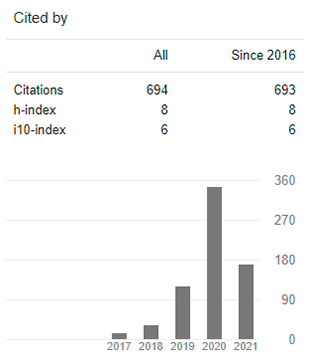Sense of Coherence in women victims of domestic violence
DOI:
https://doi.org/10.29394/Scientific.issn.2542-2987.2021.6.22.9.178-188Keywords:
sense, victims, domestic violenceAbstract
The purpose of this research is to analyze the Sense of Coherence in women who have been victims of domestic violence. A document review has been carried out and the women who come to the REDS Therapeutic Community collaborated, to whom a structured interview was applied to determine if they were victims of domestic violence by mother, father, siblings, spouse or others and, in turn, identify the type of violence suffered, at the same time the reduced Scale was applied to validate the sense of Coherence SOC-15, which assesses the dimension of understanding, management and meaning, which was standardized in Ecuador. The research has a correlational scope since it seeks to know the Sense of Coherence that the woman who has been a victim of domestic violence has, the modality is field, because the data are acquired directly from the study sample. On the total of the chosen population, the research was carried out with 30 participants. The results obtained with reference to the hypothesis raised about the sense of coherence in women victims of intra-family violence, it is observed that women were objects of violence in their family of origin, they obtained high scores on the SOC-15, which suggests that they have developed maturation processes and personal growth processes, which have provided them with tools to prevent violent actions by their partners or within the family circle. The Sense of Coherence is a tool that allows women victims of domestic violence to acquire skills to break the cycle of violence, in turn, it provides psychology professionals with strategies to provide comprehensive psychological care.
Downloads
References
Antonovsky, A. (1987a,b,c). Unraveling the mystery of health: How people manage stress and stay well. San Francisco, United States: Jossey Bass.
Bowen, M. (1991a,b). De la familia al individuo: la diferenciación del sí mismo en el sistema familiar. 1ra edición, ISBN: 84-7509-716-2. Barcelona, España: Paidós Ibérica.
Burguillos, A. (2014). Sentido de coherencia e inteligencia emocional: efecto en la ansiedad social de estudiantes universitarios. International Journal of Developmental and Educational Psychology, 4(1), 295-302, e-ISSN: 0214-9877. Recuperado de: https://www.redalyc.org/articulo.oa?id=349851787032
Humphreys, C., & Thiara, R. (2003). Mental Health and Domestic Violence: ‘I Call it Symptoms of Abuse’. The British Journal of Social Work, 33(2), 209-226, e-ISSN: 0045-3102. Recovered from: https://doi.org/10.1093/bjsw/33.2.209
Ortiz-Granja, D., Acosta-Rodas, P., Lepe-Martínez, N., Del Valle, M., & Ramos-Galarza, C. (2019). Escala Reducida para Valorar el Sentido de Coherencia: SOC 15. Revista Ecuatoriana de Neurología, 28(2), 23-27, e-ISSN: 1019-8113. Ecuador: Sociedad Ecuatoriana de Neurología.
Quirós, E. (2017a,b). El impacto de la violencia intrafamiliar: Transitando de la desesperanza a la recuperación del derecho a vivir libres de violencia. Perspectivas Psicológicas, 3-4, 155-163, ISSN: 1992-5131. República Dominicana: Publicación Oficial de la Escuela y el Instituto de Psicología de la Universidad Autónoma de Santo Domingo.
Ruiz, J. (2016). Término Crimipedia: Violencia intrafamiliar. España: Centro para el estudio de la prevención de la delincuencia de la Universidad Miguel Hernández de Elche.
Senado, J. (1999). Los factores de riesgo en el proceso salud-enfermedad. Revista Cubana de Medicina General Integral, 15(4), 453-460, e-ISSN: 1561-3038. Cuba: ECIMED.
Vetere, G., Sánchez, M., & Medina, V. (2016). Asociación entre depresión, ansiedad y estrategias de afrontamiento en mujeres víctimas de violencia de género. VIII Congreso Internacional. Argentina: Facultad de Psicología - Universidad de Buenos Aires.
Walby, S., Towers, J., Balderston, S., Corradi, C., Francis, B., Heiskanen, M., … Strid, S. (2017). Different forms of violence. In The concept and measurement of violence (pp. 57-102). Bristol, UK; Chicago, IL, USA: Bristol University Press.
Downloads
Published
How to Cite
Issue
Section
License
Copyright (c) 2021 INDTEC, C.A.

This work is licensed under a Creative Commons Attribution-NonCommercial-ShareAlike 4.0 International License.
The content of the journals of this site, are under a Creative Commons Attribution-Noncommercial-Share Alike 4.0 International License.













